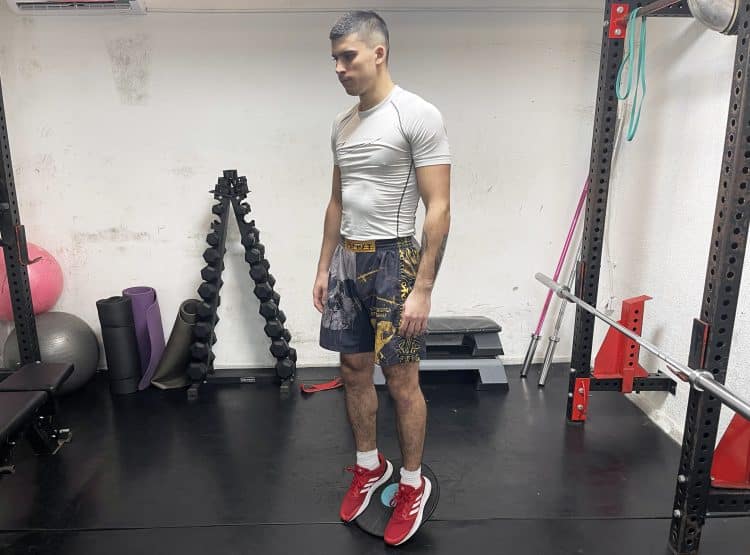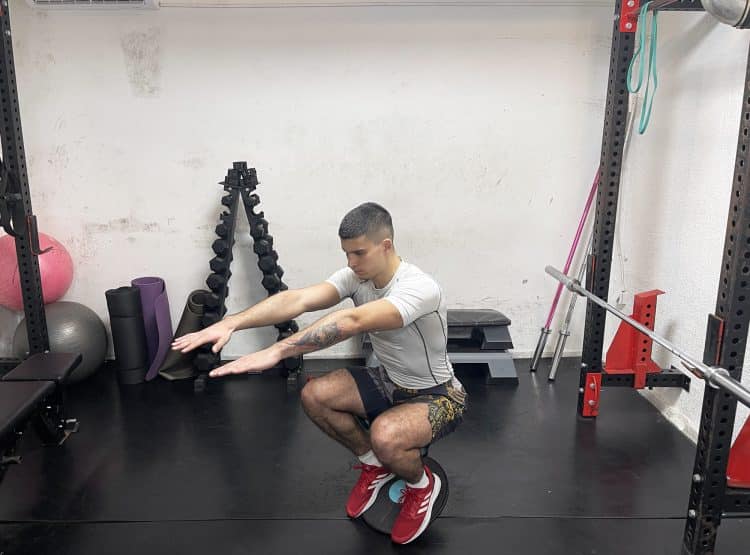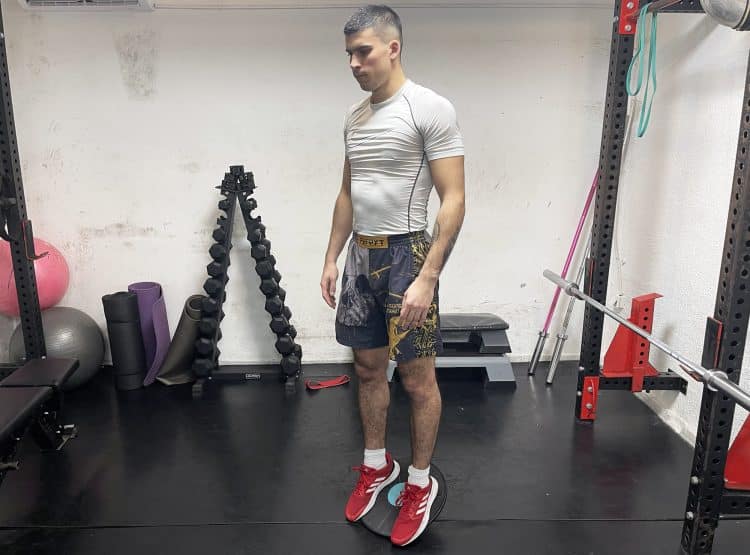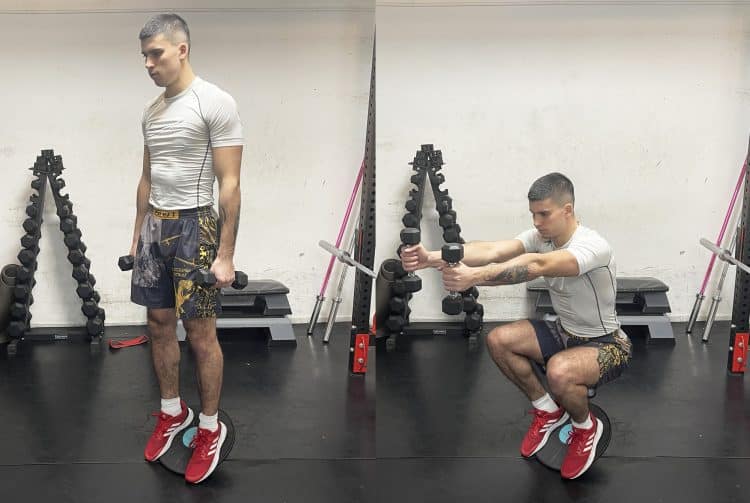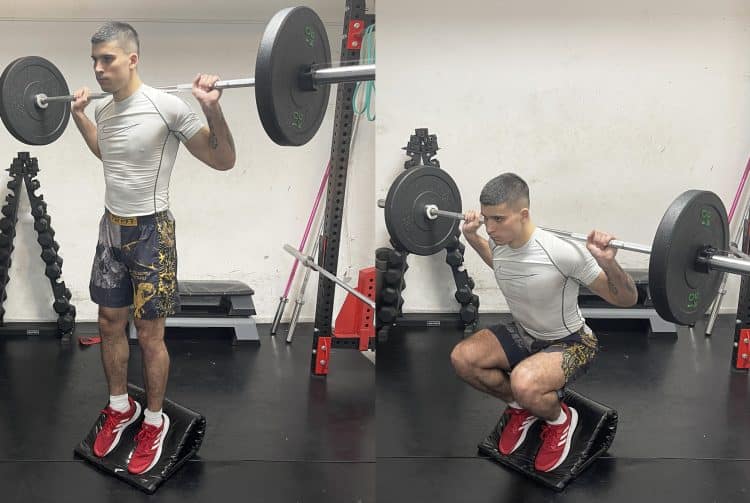If you have poor ankle mobility, more precisely poor dorsiflexion, slant board squats can be a game-changer. I implement slant board squats in my training when I want to bias my quads.
A study titled “Impact of decline-board squat exercises and knee joint angles on the muscle activity of the lower limbs” concluded that when the knee joint angle was 45, 60, and 90 degrees, the muscle activity of the rectus femoris was significantly higher. (1)
Some of my clients have poor ankle mobility. I have them perform bodyweight and weighted slant board squats to ensure they are effectively targeting their quads. That said, this doesn’t mean you should ignore improving your ankle range of motion.
In this article, I will cover the proper slant board squat form and technique, tips, most common mistakes, and best variations.
How To Perform Slant Board Squats
Here is how to do slant board squats to maximize muscle stimulation:
Step One — Assume the Starting Position
Level Up Your Fitness: Join our 💪 strong community in Fitness Volt Newsletter. Get daily inspiration, expert-backed workouts, nutrition tips, the latest in strength sports, and the support you need to reach your goals. Subscribe for free!
Place a slant board on the floor behind you and stand on it with a hip-width stance. Make sure your feet are parallel and aligned with your knees.
Ensure your back is straight, and extend your arms in front of you so the angle between your upper arm and torso is 90 degrees.
Pro Tip: Brace your core, as it will provide better stability and boost control during the squat.
Step Two — Lower Into a Squat
Bend your ankles, knees, and hips simultaneously to descend into a squat. Go as low as your mobility allows. Maintain a neutral spine throughout the entire movement. Pause at the bottom of the squat for one second before transitioning to the next phase.
Pro Tip: Visualize sitting back into the squat rather than just lowering down. This will help you maintain weight distribution and reduce undue stress on your knees.
Step Three — Extend Your Ankles, Knees, and Hips
Extend your ankles, knees, and hips to return to the starting position. Avoid locking out your knees at the top to maintain constant tension on your quads. Proceed with the next rep.
Pro Tip: Focus on driving through the entire foot, not just the balls of your feet. This will ensure balanced muscle activation and prevent overloading the knees.
Dumbbell Slant Board Squat
Barbell Slant Board Squat
Muscles Worked During Slant Board Squats
The primary muscles worked during the slant board squats include:
- Quadriceps
- Gluteus maximus
Also, the secondary muscles comprise:
- Hamstrings
- Calves
- Adductors
- Erector spinae
Best Tips For Performing Slant Board Squats
Here is how to make the most of the slant board squats:
Choose the Right Angle
Choosing the right slant board angle is crucial for maximizing quad activation. The poorer your ankle mobility, the greater the incline of the slant board should be to compensate for compromised dorsiflexion.
A bigger squat wedge will force your quadriceps muscles to work harder since tibial flexors are already pre-stretched.
Maintain Proper Alignment
Maintaining proper knee and back alignment is crucial for safety and efficiency. Your knees must always align with your toes. When you do this, you free your collateral ligaments, such as the ACL, from excessive pressure. This significantly reduces ankle injury risk.
Controlled Descent
Controlled eccentrics are crucial for maximal quad and glute engagement. Slow eccentrics will increase your muscle’s time under tension, which is also great for hypertrophy.
Additionally, controlled descent will ensure you learn the proper form and technique so you can add external resistance to progressive overload the target muscles. (2)
Start With Your Body Weight
Start with the bodyweight version of this exercise to master form, technique, and muscle contraction.
Bodyweight movements are generally safer than their weighted variations, making them an excellent choice for beginners.
Core Engagement
Engage your core muscles during complex exercises such as slant board squats for better stabilization. Core engagement plays a big part in almost every compound exercise; ignoring it can lead to potential injuries.
Level Up Your Fitness: Join our 💪 strong community in Fitness Volt Newsletter. Get daily inspiration, expert-backed workouts, nutrition tips, the latest in strength sports, and the support you need to reach your goals. Subscribe for free!
Common Mistakes During Slant Board Squats
Steer clear of these slant board squat mistakes:
Extending the Knees Over the Toes
Extending your knees over your toes can put too much pressure on your knees, which can cause injuries.
However, trained athletes don’t have to worry about this.
Assuming your knees are healthy, you can significantly benefit from letting your knees extend over your toes. In fact, trained exercisers are encouraged to extend their knees over the toes while squatting and lunging to bulletproof their joints.
Leaning Forward Too Much
Leaning too far forward will remove the tension from your quads. Bending forward transfers the tension to the posterior chain muscles, including the glutes and hamstrings. Use a bigger squat wedge if you notice yourself leaning too far forward.
Ignoring Ankle Mobility
A slant board allows you to achieve a deep squat with limited ankle mobility. However, this doesn’t mean you should forget about your poor ankle ROM. You must perform ankle mobility exercises daily, such as ankle circles or knee-to-wall ankle mobilization, to improve dorsiflexion.
As your ankle mobility improves, progress to a smaller slant board. The goal is to squat deep without using a slant board.
Not Using a Suitable Decline
Using a small slant board can keep you from achieving proper squat depth. Conversely, too big of a board will likely lead to instability and increase injury risk. Adjust your foot placement on the slant board to squat deep without straining your joints.
Slant Board Squat Variations
Here are some of the best slant board squat variations:
Slant Board Goblet Squat
Slant board goblet squats are an excellent bodyweight squat progression exercise.
Steps:
- Grab a kettlebell with both hands and hold it against your chest.
- Position your feet on the slant board.
- Assume a shoulder-width stance.
- Make sure your feet are parallel and aligned with your knees.
- Bring your arms in front of you so the angle between your upper arm and torso is 90 degrees.
- Bend your ankles, knees, and hips simultaneously to lower into a squat.
- Pause at the bottom of the squat for one second before transitioning to the next phase.
- Return to the starting position.
- Repeat for the desired reps.
Pro Tip: Keep the dumbbell or kettlebell close to your chest. This helps maintain an upright torso and counterbalances the weight, enhancing core and quad engagement.
Slant Board Single-Leg Squat
The slant board single-leg squat is an excellent unilateral exercise that will increase your lower body strength and stability.
Steps:
- Place the slant board on the floor, stand on it, shift your weight onto one leg, and lift the other leg off the floor.
- Lower as far as balance and form allow while simultaneously extending the non-working leg in front for better balance and depth.
- Engage your core muscles for better balance.
- From the bottom position, push through the heel to return to the starting position.
- Complete the desired number of reps before switching sides.
Pro Tip: Brace your core and glutes before descending. This provides a stronger base and better balance.
Slant Board Sumo Squat
This exercise emphasizes your inner thighs and gluteal muscles due to its wider stance.
Steps:
- Assume the starting position on the slant board with your feet wider than shoulder-width apart.
- Point your toes slightly outward and ensure your knees are in line with them.
- Place your hands on your chest.
- Ensure your back is straight during the entire movement.
- Bend your ankles, knees, and hips to lower into the bottom squat position.
- When your thighs break parallel, reverse the motion and return to the starting position.
Pro Tip: Focus on pushing through your heels to maximize glute activation. Keep your chest up and core engaged throughout the movement to maintain balance and form.
Slant Board Squat with Resistance Bands
This variation adds a stability challenge and extra resistance, particularly targeting the outer thighs and glutes.
Steps:
- Wrap the resistance band around your thighs just above the knees.
- Stand on the slant board with your feet shoulder-width apart.
- Lower into the bottom squat position and hold it for one second.
- Reverse the motion to return to the starting position and repeat.
Pro Tip: Ensure the band is tight enough to provide resistance but not so tight that it restricts your movement. Concentrate on pushing your knees out against the band to activate your abductors.
Slant Board Squat with Medicine Ball
Incorporating a medicine ball into the slant board squat enhances core engagement and overall balance.
Steps:
- Hold a medicine ball at chest level while standing on the slant board.
- Assume a shoulder-width stance with your feet.
- Slightly point your toes outward, and keep your back straight.
- Lower into the bottom squat position.
- Hold it for one second.
- Reverse the motion by extending your ankles, knees, and hips to return to the starting position.
Pro Tip: Use the weight of the medicine ball to counterbalance your squat, which helps in achieving a deeper range. Keep the movement controlled, especially when returning to the standing position to engage the core effectively.
Wrapping Up
The slant board squat is an excellent variation for all those suffering from inadequate ankle mobility and poor dorsiflexion mechanics. I advise incorporating slant board squats regularly in your workouts to work the quads through their full range of motion.
However, this doesn’t mean you should avoid working on your ankle mobility since this can only lead to more problems and potential injuries in the future. In the comments below, let me know your thoughts on slant board squats and how you implement them in your workouts.
References:
- Lee D, Lee S, Park J. Impact of decline-board squat exercises and knee joint angles on the muscle activity of the lower limbs. J Phys Ther Sci. 2015;27(8):2617-2619. doi:10.1589/jpts.27.2617
- Plotkin D, Coleman M, Van Every D, et al. Progressive overload without progressing load? The effects of load or repetition progression on muscular adaptations. PeerJ. 2022;10:e14142. Published 2022 Sep 30. doi:10.7717/peerj.14142
Relevant Articles:
Article Updates Timeline:
Our editorial team experts constantly update the articles with new information & research, ensuring you always have access to the latest and most reliable information.
January 8, 2024
Written By
Vanja Vukas
Edited By
Vidur Saini
Fact Checked By
Dr. Malik
Interested in measuring your progress? Check out our strength standards for Bodyweight Squat, Goblet Squat, Squat, and more.

